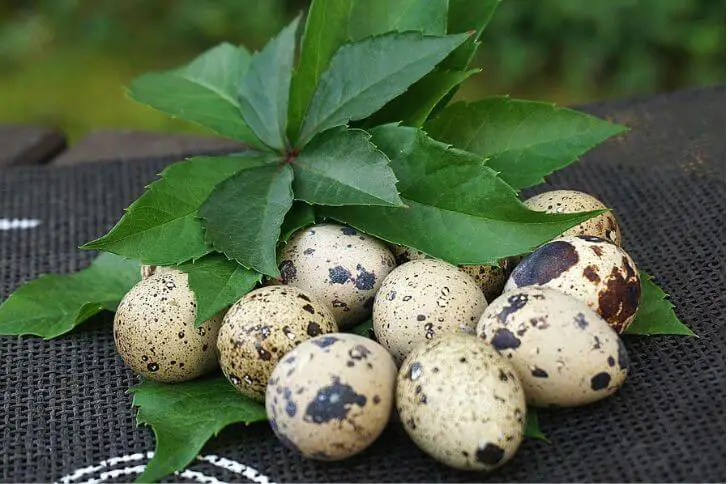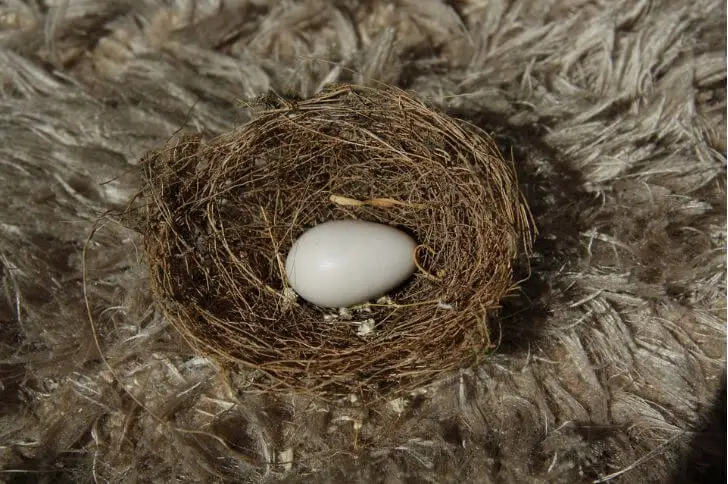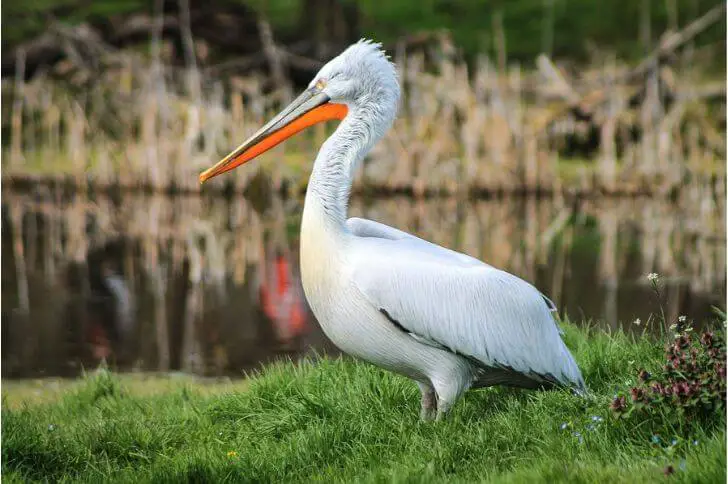The American robin is a plump songbird with a rusty-red breast and gray upperparts. Its undertail is white, and it has black head with a distinctive yellow bill.
This bird is found across North America, from Alaska to Newfoundland. The male and female robins have similar plumage, although the female is usually duller in color.
Now, you are here because you are wondering if the robin juvenile shares the similar plumage and habits with its parents? Below we discuss facts about the early stages of life of American robins; plumage, feeding, habitats and more. Keep reading to learn more.
What is a juvenile robin?
A juvenile robin is a young bird that has not yet reached adulthood. These birds are typically smaller than adult robins and have darker, more mottled plumage. Juvenile robins also have shorter tails and wingspans. While they are not yet sexually mature, juvenile robins still possess the ability to mate and produce offspring.
Additionally, their calls become deeper in pitch as they reach maturity. Ultimately, juvenile robins transition into adulthood after about three months of life.
What are the stages of a baby robin?
A baby robin goes through several stages before it leaves the nest and becomes an adult. The first stage is the egg stage. The female American robin lays anywhere from three to five eggs in a nest made of twigs, grass, and leaves. She then incubates them for about two weeks. During this time, the male American robin takes on food delivery duties..
The next stage is the hatchling stage. When the eggs hatch, the babies are naked and have their eyes closed. They can’t yet fly or feed themselves. The parents take turns feeding them every few hours by putting food directly into their mouths.
After about two weeks, the babies enter the fledgling stage. Their feathers start to come in and they begin to look like miniature adults. They start to leave the nest to perch on nearby branches and learn to fly.
What do American robin juveniles look like?
Most robin juveniles are a dull grayish-brown with a speckled breast. Their belly and undertail coverts are usually a lighter gray or white. Some fledged young have a faint whitish tinge around their eyes. As they first start to grow feathers, they look very scruffy. After about four weeks, most of their body is covered in feathers and they start to look more like the adult female robin.
Related Read: Learn about the pileated woodpecker juvenile
How big are juvenile robins?
In North America, the average juvenile robin is about 6 to 8 inches long. The wingspan of a juvenile robin is about 10 to 12 inches. The robin juvenile typically weighs between 1.5 and 2 ounces.
During their first few weeks of life, juvenile robins are dependent on their parents for food and shelter. After about a month, they are able to fly and fend for themselves. Robins typically live for about 9 years in the wild.
How can one tell how old a robin is?
There are several ways to tell how old a robin is. One way is to look at the bird’s leg bands. If the bird has a metal band on its long legs, you can contact the banding authority to find out when and where the bird was banded.
Another way to determine age is by looking at the plumage. The feathers of juvenile birds are usually darker and duller than those of adults plus a robin juvenile spots a speckled breast. The amount of wear on a bird’s feathers can also be used to estimate age.
Molt patterns can also give clues to a bird’s age. Birds typically molt (lose and grow new feathers) once per year.
What do young robins eat?
As most people know, robins are one of the first birds to herald the arrival of spring. Less well known is what these beautiful creatures eat to survive.
While in urban areas we often see robins eating insects or worms, those in rural areas have a much more varied diet. For the first 10 days or so after hatching, baby robins are fed a diet of insects by their parents. After that, they begin to eat more berries and fruits.
By 2-3 weeks old, they are eating mostly on their own and their diet consists mainly of earthworms. By 4-5 weeks old however, they are beginning to look more like adults and their diet starts to resemble that of an adult robin – which includes lots of insects!
So, next time you see a young robin scrounging around your yard, know that it’s not just looking for a juicy worm!
How long does the juvenile robins molt last?
The juvenile robin molt lasts anywhere from 6 to 8 weeks. The process begins when the juveniles lose their downy feathers and start to grow their first set of true feathers.
The new feathers are initially soft and weak, but they gradually harden and strengthen over the course of the molt. By the end of the molt, the juveniles will have a full set of strong, adult feathers.
During the molt, juveniles are unable to fly very well, if at all. This makes them more vulnerable to predators and other dangers.
For this reason, many juveniles will stay close to their parents during this time. Like other robins, once the molt is complete they will be able to take flight and explore the world on their own.
How do you tell if a robin is a fledgling?
As the weather gets warmer, you may start to see more robins in your yard. But how can you tell if the robin is a fledgling?
There are a few things you can look for to tell if a robin is a fledgling. One is that the bird will be mostly feathered with only a few downy feathers remaining.
Another is that the fledgling will be able to fly short distances. Finally, the fledgling will beg for food from its parents.
If you see a robin that meets all of these criteria, you’ve found a fledgling! Enjoy watching it grow and learn to fly!
How long does it take a robin fledgling to learn to fly?
It takes around three weeks for a robin fledgling to learn how to fly. This process begins with the young bird leaving the nest and spending time on the ground, where it will practice flapping its wings.
After a few days of this, the bird will start to make short flights, and eventually, it will be able to fly long distances.
During this time, the bird’s parents will still be nearby, providing food and support. Once the young bird has mastered flying, it will begin to venture out on its own and live independently.
How long do young robins stay with their parents?
Most young robins stay with their parents for about a month before they leave the nest. After this period, they are on their own. They have to fend for themselves.
Although some young robins may stay close to their parents’ territories and even help them raise subsequent broods of chicks, others disperse widely. Some immature males may even travel great distances, up to 600 miles from where they were born.
Can a fledgling survive on its own?
No, a fledgling cannot survive on its own. The first few weeks of a bird’s life are crucial to its development and it is during this time that it needs the care and attention of its parents.
Once it has left the nest, it is still dependent on its parents for food and shelter. If a fledgling is separated from its parents, it will likely die.
Do juvenile robins revisit their homes?
Yes, according to a new study, juvenile robins do revisit their homes. The study found that almost two-thirds of young robins returned to their natal area, with males more likely to return than females.
The study provides the first evidence that young robins use landmarks and other cues to find their way back home. The findings suggest that juveniles may have a better chance of survival if they can find their way back to areas where food is plentiful and predators are scarce.
How long does it take for a robin to mature?
A robin matures anywhere from 4 to 6 weeks after it hatches. The young bird will leave the nest about 2 weeks after it is able to fly. Once a robin leaves the nest, it is on its own to fend for itself and to find a mate.
What do you do if you find a robin fledgling?
If you find a robin fledgling, the best thing to do is to leave it alone. The parents are usually close by and will take care of it. If you must move it, put it in a nearby shrub or tree. Keep dogs and cats away from the area.
What time of the year can you see young robins?
In early spring, you can see young robins hopping around in your backyard. These little birds are so cute and full of energy! You may even see them chasing each other or playing with insects.
During the summer months, young robins are still around but they are harder to spot. They are usually in trees or on rooftops, out of reach. But if you’re lucky, you might catch a glimpse of one flying from branch to branch.
In the fall, young robins are starting to look more like their adult counterparts. They have lost their baby feathers and their beaks have turned orange-yellow. You might see them eating berries or seeds from your bird feeder.
Do fledglings need water?
No, fledglings do not need water. Fledglings are able to get all the water they need from the food they eat. However, if you see a fledgling that looks like it is dehydrated, you can give it some water. Just make sure that the water is at room temperature and that you give the fledgling a few drops at a time.
What do you feed a fledgling robin?
When they first leave the nest, they are not able to hunt for food on their own. It is important to provide them with food that will give them the energy they need to survive and grow.
One of the best things you can feed a fledgling robin is live mealworms. They are high in protein and fat, which helps the young bird grow. You can purchase live mealworms at most pet stores.
Another good option for food is hard-boiled eggs. This option is high in protein and fat, which will help the young bird grow.
Where do robins sleep at night?
As the sun sets, robins return to their roosts for the night. But where do these birds go? Robins don’t build nests, so they must find other places to sleep. Some robins sleep in trees, while others may sleep on the ground in dense vegetation.
In urban areas, robins have been known to roost on buildings and other man-made structures. No matter where they spend their nights, robins are usually safe from predators. So the next time you see a robin during the day, remember that at night it’s likely fast asleep somewhere close by.
Sources:
https://www.audubon.org/field-guide/bird/american-robin
https://en.wikipedia.org/wiki/American_robin
Hi fellow bird watcher. Welcome to our small corner of the world. At the spanishbirdguides.com our mission is to share with other bird watchers the things we love about birds, where to go bird watching within the United States, and more. I’d also love to hear from you. Feel free to contact me about your bird watching escapades, share videos, photos and more.



